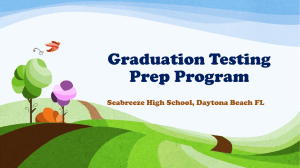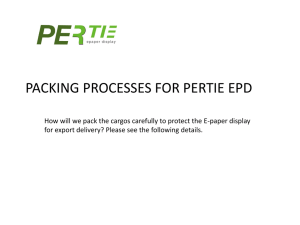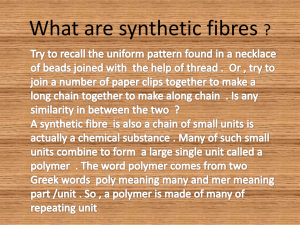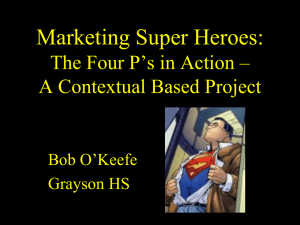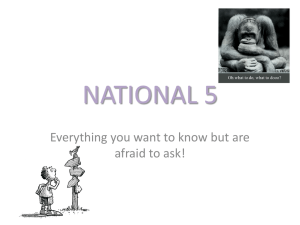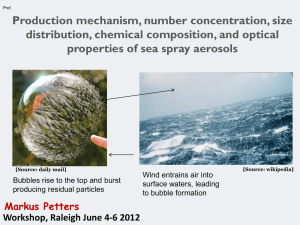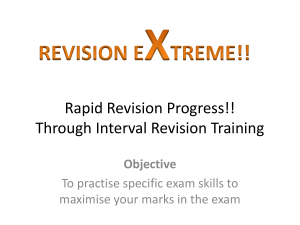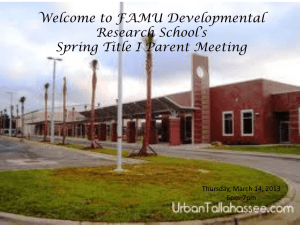5th Grade Essential Labs
advertisement
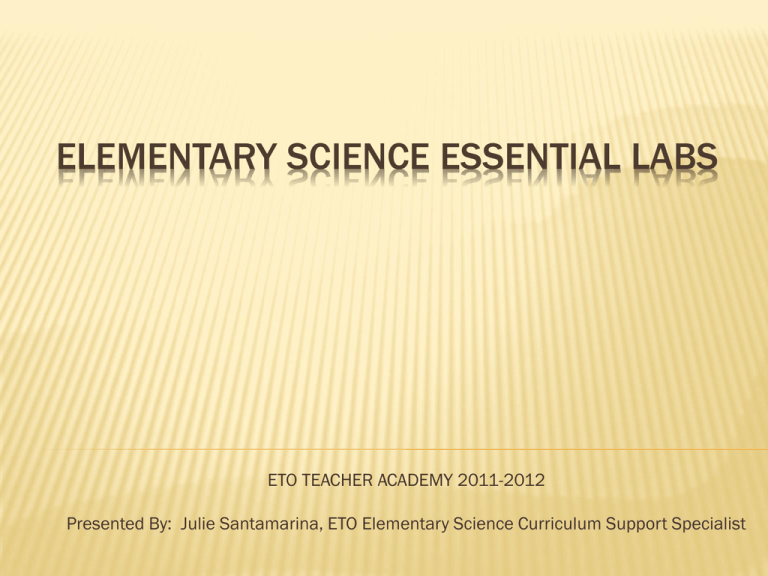
ELEMENTARY SCIENCE ESSENTIAL LABS ETO TEACHER ACADEMY 2011-2012 Presented By: Julie Santamarina, ETO Elementary Science Curriculum Support Specialist COMMON BOARD CONFIGURATION (CBC) DATE: August 10, 2011 BELL RINGER: FCAT Style ?: SC.5.N.1.3 BENCHMARK: 4th & 5th Grade Essential Labs OBJECTIVE: Today we will examine the 4th and 5th grade ETO Essential Lab Documents and how they will assist us in our work to enhance student achievement by a hands on minds on approach and then tying the labs to FCAT style question. ESSENTIAL QUESTION: How can utilizing the Essential Lab Document impact teaching and increase student achievement? VOCABULARY: Annually Assessed Benchmarks, variable, scientific process, interactive journals EXIT SLIP: How can utilizing the Essential Lab Document impact teaching and increase student achievement? AGENDA: •Purpose •FCIM Correlation •Annually Assessed Benchmarks •4th v.s 5th grade •Processing Time •Pacing Guide •Bubble Mania (5th Grade) •Teacher Reference Page •Student Lab Sheet •FCAT style Quiz •Lesson Review and Resources •Revisit Essential Question •Exit Slip •Homework Instruction HOME LEARNING: Review today’s lesson and map out your next steps to utilize these resources in your daily lessons. ESSENTIAL QUESTION How can utilizing the Essential Lab Document impact teaching and increase student achievement? PURPOSE The purpose of this document is to provide a venue for 4th and 5th grade science teachers to facilitate the discussion of the New Generation Science Sunshine State Standards Annually Assessed Benchmarks in the 5th grade science course Allows the students to grow in critical thinking within the content of the benchmark. The labs were developed to enable all 4th and 5th grade science teachers to address these very important concepts in their science courses prior to the Science FCAT This document is intended to be used by the 4th and 5th grade science teachers so that ALL teachers within this grade level can collaborate as they work together, plan together, and rotate lab materials among classrooms ESSENTIAL LABS + FCIM Pacing Guide (District Provided) Focus Calendar (School Specific and Data Driven) PDCA Inst ruct ional Cycle PLAN • Data Disaggregation • Calendar Development ACT FCAT Explorer www.explorelearning.com (Gizmos) Differentiated Instruction Discovery Education DO •Lessons •Essential Labs •Science Projects and Activities • Direct Instructional Focus CHECK • Tutorials • Assessment • Enrichment • Maintenance • Monitoring •FOCUS Assessment ANNUALLY ASSESSED BENCHMARKS BIG IDEA 1: THE PRACTICE OF SCIENCE SC.4.N.1.1 SC.4.N.1.2 Raise questions about the natural world, use appropriate reference materials that support understanding to obtain information (identifying the source), conduct both individual and team investigations through free exploration and systematic investigations, and generate appropriate explanations based on those explorations. Compare the observations made by different groups using multiple tools and seek reasons to explain the differences across groups. Recognize and explain the need for repeated experimental trials. SC.4.N.1.3 SC.5.N.1.1 Define a problem, use appropriate reference materials to support scientific understanding, plan and carry out scientific investigations of various types such as: systematic observations, experiments requiring the identification of variables, collecting and organizing data, interpreting data in charts, tables, and graphics, analyze information, make predictions, and defend conclusions. Also assesses SC.3.N.1.1, SC.4.N.1.1, SC.4.N.1.6, SC.5.N.1.2, and SC.5.N.1.4. BIG IDEA 2: THE CHARACTERISTICS OF SCIENTIFIC KNOWLEDGE SC.5.N.2.1 SC.5.N.2.2 Recognize and explain that science is grounded in empirical observations that are testable; explanation must always be linked with evidence. Also assesses SC.3.N.1.7, SC.4.N.1.3, SC.4.N.1.7, SC.5.N.1.5, and SC.5.N.1.6 Recognize and explain that when scientific investigations are carried out, the evidence produced by those investigations should be replicable by others. ANNUALLY ASSESSED BENCHMARKS BIG IDEA 5: EARTH IN SPACE AND TIME SC.4.E.5.1 SC.4.E.5.2 SC.4.E.5.3 Observe that the patterns of stars in the sky stay the same although they appear to shift across the sky nightly, and different stars can be seen in different seasons Describe the changes in the observable shape of the moon over the course of about a month. Recognize that Earth revolves around the Sun in a year and rotates on its axis in a 24-hour day. Relate that the rotation of Earth (day and night) and apparent movements of the Sun, Moon, and stars are connected. SC.4.E.5.4 Also assesses SC.4.E.5.1, SC.4.E.5.2, and SC.4.E.5.3 Recognize that a galaxy consists of gas, dust, and many stars, including any objects orbiting the stars. Identify our home galaxy as the Milky Way. SC.5.E.5.1 Also assesses SC.3.E.5.1, SC.3.E.5.2, and SC.3.E.5.3 Distinguish among the following objects of the Solar System – Sun, planets, moons, asteroids, comets – and identify Earth’s position in it. SC.5.E.5.3 Also assesses SC.5.E.5.2. ANNUALLY ASSESSED BENCHMARKS BIG IDEA 6: EARTH STRUCTURES SC.4.E.6.1 SC.4.E.6.2 Identify the three categories of rocks: igneous, (formed from molten rock); sedimentary (pieces of other rocks and fossilized organisms); and metamorphic (formed from heat and pressure) Identify the physical props of common earth-forming minerals, including hardness, color, luster, cleavage, and streak color, and recognize the role of minerals in the formation of rocks. Also assesses SC.4.E.6.1 Recognize that humans need resources found on Earth and that these are either renewable or nonrenewable. SC.4.E.6.3 Also assesses SC.3.E.6.6 Describe the basic differences between physical weathering (breaking down of rock by wind, water, ice, temperature change, and plants) and erosion (movement of rock by gravity, wind, water, and ice). SC.4.E.6.4 ANNUALLY ASSESSED BENCHMARKS BIG IDEA 8 : PROPERTIES OF MATTER SC.5.P.8.1 SC.5.P.8.3 Compare and contrast the basic properties of solids, liquids, and gases, such as mass, volume, color, texture, and temperature. Also assesses SC.3.P.8.1, SC.3.P.8.2, SC.3.P.8.3, and SC.4.P.8.1 Demonstrate and explain that mixtures of solids can be separated based on observable properties of their parts such as particle size, shape, color, and magnetic attraction. Also assesses SC.5.P.8.2 BIG IDEA 9: CHANGES IN MATTER Investigate and describe that many physical and chemical changes are affected by temperature. SC.5.P.9.1 ANNUALLY ASSESSED BENCHMARKS BIG IDEA 10: FORMS OF ENERGY SC.5.P.10.1 SC.5.P.10.2 SC.5.P.10.4 Investigate and describe some basic forms of energy, including light, heat, sound, electrical, chemical, and mechanical. Also assesses SC.3.P.10.1, SC.3.P.10.3, SC.3.P.10.4, SC.3.P.11.1, SC.3.P.11.2, SC.4.P.10.1, and SC.4.P.10.3 Investigate and explain that energy has the ability to cause motion or create change. Also assesses SC.3.P.10.2, SC.4.P.10.2, and SC.4.P.10.4 Investigate and explain that electrical energy can be transformed into heat, light, and sound energy, as well as the energy of motion. Also assesses SC.3.E.6.1, SC.4.P.11.1, SC.4.P.11.2, SC.5.P.10.3, SC.5.P.11.1, and SC.5.P.11.2. BIG IDEA 13: FORCES AND CHANGES IN MOTION SC.5.P.13.1 Identify familiar forces that cause objects to move, such as pushes or pulls, including gravity acting on falling objects. Also assesses SC.3.E.5.4 and SC.4.P.8.4 Investigate and describe that the greater the force applied to it, the greater the change in motion of a given object. SC.5.P.13.2 Also assesses SC.4.P.12.1, SC.4.P.12.2, SC.5.P.13.3, and SC.5.P.13.4. ANNUALLY ASSESSED BENCHMARKS BIG IDEA 14: ORGANIZATION AND DEVELOPMENT OF LIVING THINGS SC.5.L.14.1 Identify the organs in the human body and describe their functions, including the skin, brain, heart, lungs, stomach, liver, intestines, pancreas, muscles and skeleton, reproductive organs, kidneys, bladder, and sensory organs. SC.5.L.14.2 Compare and contrast the function of organs and other physical structures of plants and animals, including humans, for example: some animals have skeletons for support — some with internal skeletons others with exoskeletons — while some plants have stems for support. Also assesses SC.3.L.15.1 and SC.3.L.15.2. BIG IDEA 16: HEREDITY AND REPRODUCTION SC.4.L.16.4 Compare and contrast the major stages in the life cycles of Florida plants and animals, such as those that undergo incomplete and complete metamorphosis, and flowering and non-flowering seedbearing plants. ANNUALLY ASSESSED BENCHMARKS BIG IDEA 17: INTERDEPENDENCE Trace the flow of energy from the Sun as it is transferred along the food chain through the producers to the consumers. Also assesses SC.3.L.17.2 and SC.4.L.17.2. AA MC SC.4.L.17.3 Compare and contrast adaptations displayed by animals and plants that enable them to survive in different environments such as life cycles variations, animal behaviors and physical characteristics. SC.5.L.17.1 Also assesses SC.3.L.17.1, SC.4.L.16.2, SC.4.L.16.3, SC.4.L.17.1, SC.4.L.17.4, and SC.5.L.15.1. DOCUMENT FORMAT INTRODUCTION RESOURCES •MATERIALS LIST (SPECIFIC TO EACH LAB) •LABORATORY SAFETY CONTRACT •LAB ROLES •ANNUALLY ASSESSED BENCHMARK LAB ACTIVITIES •TEACHER RESOURCE PAGE •STUDENT LAB SHEET (FOLLOW UNIFORM TEMPLATES SIMILAR TO MIDDLE SCHOOL) •FCAT STYLE QUESITONS (3-10 DEPENDING ON BENCHMARK) APPENDIX •ESSENTIAL QUESTIONS RELATED TO LABS •GIZMO’S RELATED TO LABS •DISCOVERY CLIPS RELATED TO LABS SC.5.N.1.1 BUBBLE MANIA LAB cups o spoons Various detergents:(Joy, Palmolive, Dawn, etc.) straws water rulers plastic tablecloths or large garbage bags glycerin (optional) can be added to each of the soap solution to improve the consistency of the solution. SC.5.N.2.1 FIZZLING FUN LAB water measuring cup or graduated cylinder zip-lock bag paper towel teaspoon baking soda vinegar trays or newspaper (optional) safety goggles SC.5.N.2.2 CHEMICAL CHANGE IN A BAG LAB damp rid baking soda 50 mL of red cabbage juice or 30 mL of phenol red solution Ziploc bags (3 per group) graduated cylinder spoon (s) cups (optional) SC.5.E.5.1/SC.5.E.5.3 SOLAR STRETCH LAB 11 stakes (2-3 ft. long) hammer 11 tag board cards trundle wheel staple gun and staples various size balls Basketball or similar sized ball Measuring tape SC.5.E.7.1 RAINMAKER LAB o 1 hot plate o ice cubes o 1 pie pan o 1 teakettle or small pot o oven mitt o Water Dance by Thomas SC.5.P.8.1 APPLE OF MY EYE LAB o o o o o o Balance Measuring tape Ruler 1 apple 1 plastic knife Container with water (enough to see if apple floats or sinks) MATERIALS PAGE SC.5.E.7.3 DON’T PRESSURE ME LAB o NEWSPAPER o PLASTIC CUP o WOODEN RULER OR SLAT o CARDBOARD o o o o o o o o o o o o o o o Barometer 1 bucket coffee can with a lid or a jar balloon rubber band hammer Safety goggles scissors ice pick straw Making a Weather Station, index card Natalie Lunis, Benchmark Educ. glue stick metric ruler plastic soda bottle with a screw-on lid masking tape SC.5.P.8.3 DOES IT DISSOLVE LAB o plastic cups o 1 tsp. white sugar o Graduated Cylinder o Sand paper o 1 tsp. pepper o Paper towels o 1 tsp. cinnamon o 1 tsp. salt o 1 tsp. baking soda SC.5.P.9.1 THE HEAT IS ON LAB 2 cans the same height 1 votive candle clock or timer safety goggles matches 10 chocolate chips toothpicks paper towels heavy duty aluminum foil SC.5.P.10.1 HOW DOES SOUND TRAVEL THROUGH DIFFERENT MATERIALS LABS o 3 balloons o Water o sand o 1 Dcell I FINALLY SEE THE LIGHT LAB o o o SOLAR CANS LAB SC.5.L.14.2 BRAIN DRAIN OLYMPICS LAB 2 cans White paper Black paper 2 thermometers Paper masking tape stopwatch or clock with second hand 1 man’s shirt with buttons 1 large jar of peanut butter 1 bolt with a screw-on nut 1 plastic knife SC.5.P.10.2 SLINGSHOT LAB Toy car Meter Tape Goggles (optional) Tape 3x5 index card SC.5.P.10.4 ELECTRICAL ENERGY TRANSFORMATION LAB o o o loaf of bread tubular fluorescent bulb paper paper clips paper plates 1 pad of writing paper scissors several sheets of paper 1 box of paper clips 1 man’s shoe with laces pencil SC.5.L.17.1 BUILD A BETTER BEAK LAB SC.5.P.13.1/SC.5.P.13.2 RAMPS AND SLIDERS overhead projector/document camera masking tape balance sphere (e.g. marble) masses for balance commercial ramp and slider or slider: ½ paper cup milk carton with an open end ramp: ruler with a groove 1 clothespin 1 toothpick plastic cup 1 plastic spoon measuring tape calculator graph paper carpet, tile sandpaper, wax paper) SC.5.L.14.1 1 pair of scissors raisins drinking straw pieces in a container of shredded paper marbles DIGESTION o CASH REGISTER TAPES o BUTCHER PAPER o GLUE o CONSTRUCTION PAPER o SCISSORS o CALCULATOR foam packing squiggles aluminum pan of water one-minute timer LUNG POWER 1 plastic tub or basin flexible straws 1 plastic, gallon jug measuring cup or graduated cylinder 1 index card 1 permanent marker paper towels newspaper metric measuring tapes FILTERING SYSTEM o o o Will I See the Light? activity sheet o 1 flashlight bulb o 10-15 cm wire o wire strippers o o o o coffee pot and filter (optional) 2 plastic cups food coloring 1 coffee filter 1 piece of chalk model of the human body 50 ml of water 1 small spoon paper towels 1 rubber band Bubble Mania Lab Report- Teacher Reference Form Essential Question: Why is it important to repeat the experiment at least three times? To ensure that the results of the experiment are valid or reliable, and to ensure that mistakes were not made during the experiment. Benchmark: SC.5.N.1.3- Recognize and explain the need for repeated experimental trials. Problem Statement: How does the brand of detergent affect the size of the bubble it will make? Hypothesis: If various detergents are tested, then ______________will make the largest bubbles. Materials: 3 cups spoon various detergents of your choice (Joy, Palmolive, Dawn, etc.) straws water rulers plastic tablecloths or large garbage bags to spread on the table for easy clean-up. glycerin (optional) can be added to each of the soap solution to improve the consistency of the solution. Note: Be sure that you have pre-labeled the cups with a permanent marker with the names of the detergents for the students. Moreover, the same amount of water should be added to each cup to ensure consistency with the soap solutions. The teacher can make the soap solution ahead of time for the students or the teacher can have the students make the soap solution as a group. Procedures: 1. Make a drop of each detergent on the table with your medicine dropper. 2. Find an air bubble and blow into it with a straw. 3. After the bubble has popped, measure the width of the bubble. 4. Record your results in your data table. 5. Repeat steps 1-4 the other detergents. Data: Detergents BIG IDEA 1 THE NATURE OF SCIENCE Width of Bubble (inches) Trial 1 Trial 2 ______ cm _____cm ______ cm _____cm ______cm _____cm Trial 3 _______cm _______cm _______cm Total (Add up) ______cm ______cm ______cm Variable: (What was changed during the experiment?) The different types of detergent Control: What factor stayed the same for each experiment? The amount of detergent that was added to the water to make a soap solution, all of the soaps were dish detergents, all of the bubbles were blown on the same surface, the same amount of water were added to the detergent to make a soap solution, etc. Conclusion: Students should compare their prediction with the results of their data to complete the conclusion portion of their lab report. Title: Bubble Mania Lab Benchmarks: SC.5.N.1.3-Recognize and explain the need for repeated experimental trials. Problem Statement (10 POINTS): How does ___________________________________________________________ affect______________________________________________________________? Control (5 POINTS) Variable (5 POINTS) Hypoth esis (15 POINTS): If then _____________________________________________________ Materials: , 3 cups per group (label each cup with the name of the detergent solution) plastic spoon various dish detergents straws water rulers plastic table cloth or large garbage bags (optional) Procedure: BIG IDEA 1 THE NATURE OF SCIENCE 1. Pour two (3) teaspoons of each detergent on the table with your plastic spoon. 2. Find an air bubble in the puddle of the soap mixture and blow into it with a straw. 3. After the bubble has popped, measure the width of the bubble imprint with a ruler in centimeters. 4. Record your results in your data table. 5. Repeat steps 1-4 with the other detergents. Observations (10 POINTS): Students should write what they observe about the various detergents. Detergent Observations Data (20 POINTS): Detergents Trial #1 Trial #2 Trial #3 Total Width (cm) (Add across) ______ cm _____cm _______cm ______cm ______ cm _____cm _______cm ______cm ______cm _____cm _______cm ______cm Conclusion (35 POINTS): After analyzing the data it was determined that the hypothesis was . (Correct OR Incorrect), because learned that ____ To conclude, from this lab I ______________________________________________________________ BIG IDEA 1 THE NATURE OF SCIENCE Science Mini-Assessment Grade 5 SC.5.N.1.1 Form A 1. Hector experiments with honey, vegetable oil, and colored water. One at a time, he slowly adds 30 milliliters of each liquid into a beaker. He observes what happens, then draws the picture below. Which is LEAST important for Hector to record in this experiment? A. B. C. D. 2. BIG IDEA 1 THE NATURE OF SCIENCE the amount of each liquid used the order in which the liquids formed layers the type of liquids used the air pressure and temperature Kama made three paper airplane designs using plain paper. Standing in the same spot each time, she threw each airplane, measured the distance it flew, in meters, and recorded the data she collected. Kama rebuilt plane C using construction paper. The new plane flew 10.7 meters. What statement is TRUE? Model Airplane Data Distance Paper Plane Flown Design (meters) A 2.5 B 4.7 C 6.3 A. B. C. D. Plane C would not fly when made of construction paper. Plane C did not fly as far when made of construction paper. Plane C flew farthest when made of construction paper. The type of paper used did not affect the distance plane C flew. 3. Look at the table. Year 1910 1930 1950 1970 Average Annual Temperature 55° F 58° F 59° F 61° F Average Annual Rainfall 57 cm 77 cm 84 cm 65 cm This data was collected in one city by many scientists over the years. What would a scientist use this data for today? A. B. C. D. predicting the weather understanding the water cycle forecasting the movement of air masses forming a description of the local climate 4.. Medical and technological advances often occur as scientists look for ways to solve problems facing humans. How has the development and widespread use of a tool that measures blood pressure improved the quality of life for people on Earth? E. F. G. H. This tool helps doctors cure bacterial infections. This tool helps doctors identify people who have cancer. This tool helps doctors treat people with variable levels of blood sugar. This tool helps doctors identify people with elevated blood pressure levels. 5. In Tania’s city, workers are making changes to the city sewer system. These changes will stop sewage, and the bacteria it contains, from getting into the river and other local water bodies when it rains. How does this project help the people living in Tania’s city? BIG IDEA 1 THE NATURE OF SCIENCE I. It helps people by cleaning the air they breathe. J. It helps people by lowering their taxes. K. It helps people by making the water safer to use. D. It helps people by making the soil more fertile 4TH GRADE CONTENT VS. 5TH GRADE CONTENT APPENDIX B FCAT 2.0 NGSSS 4TH GRADE YEAR AT A GLANCE 5TH GRADE YEAR AT A GLANCE PROCESSING MOMENT 1. 2. 3. Think – Pair – Share (TPS) Think about the information provided so far. Pair up with someone Share with your partner something NEW you’ve learned. LET’S INVESTIGATE Hector experiments with honey, vegetable oil, and colored water. One at a time, he slowly adds 30 milliliters of each liquid into a beaker. He observes what happens, then draws the picture below. Which is LEAST important for Hector to record in this experiment? A. the amount of each liquid used B. the order in which the liquids formed layers C. the type of liquids used D. the air pressure and temperature RESOURCES Essential Labs: eto.dadeschools.net Standards: http://www.floridastandards.org/Standards/FLStanda rdSearch.aspx Item Specifications: http://www.floridastandards.org/Resource/FCAT_Item _Specifications.aspx FCAT 2.0: http://fcat.fldoe.org/fcat2/ fcatexplorer.com Essential Question EXIT SLIP How can utilizing the Essential Lab Document impact teaching and increase student achievement? QUESTIONS?
